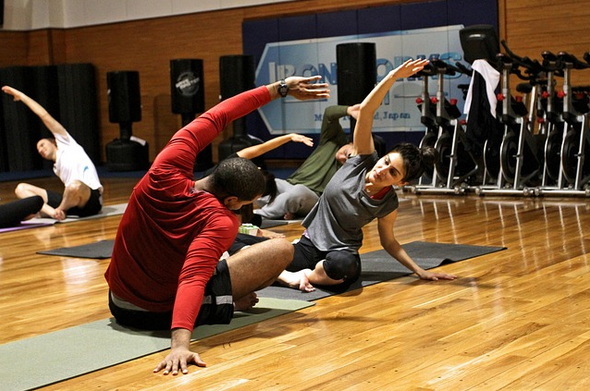Shoulder Impingement Syndrome, also called Swimmer’s Shoulder, is a disorder of the rotator cuff. Rotator cuff disorder are among the most common causes of pain and disability in the shoulder.

Shoulder impingement syndrome was first introduced in a medical paper released by Charles Neer in the year of 1972. Now, the term “impingement syndrome” is associated with shoulder pain that stems from a mechanical issues of the rotator cuff through the ligament identified as the “coraco-acromial”.
If an individual suffers from this medical issue and does not receive treatment, the impingement may then progress to a partial or a complete tendon rupture of the rotator cuff.
TABLE OF CONTENTS
The Shoulder
Basic anatomy of the shoulder is important to understand. The joint of the shoulder is a ball and shallow socket. The shallow socket is part of the shoulder blade. The ball is located on the top area of the arm.
Just above the ball is a ligament that is attached directly to the shoulder blade. It is referred to as an “acromion” ligament and forms a type of arch. The area that rests between the joint and the formed arch is medically identified as the “sub-acromial space”.
The rotator cuff is a group of tendons and muscles. This group is responsible for moving the shoulder and providing control over the general position of the ball that rests on the shallow socket. This group attaches at the shoulder blade. It then passes through the sub-acromial space.
There is a special tendon, called the “supraspinatus” that is located in the middle of the space. Then, the “bursa”, which is a small lining of fluid, acts as a cushion to the tendon from the highest point of the arch. When the arm is moved, the group of muscles and tendons works to make certain that the ball stays centered on the shallow socket.

Sub-acromial Impingement. Case courtesy of Mr Andrew Murphy, Radiopaedia.org. From the case rID: 48224
What is Shoulder Impingement Syndrome?
Shoulder impingement syndrome, or “swimmer’s shoulder”, happens when there is wear and tear on the rotator cuff.
The presence of damage and/or degeneration seems to negatively impact the supraspinatus tendon in the space of the sub-acromial region.
There may be swelling, tears, rips, and other forms of damage and/or degeneration.
Many are simply just prone to this issue as they age. For others, the damage and/or degeneration stems from the completion of certain activities, such as lifting, gardening, trimming hedges, painting, or other overhead activities. When the tendon is impinged, it hurts, may start to swell, and generally becomes weak.
As the tendon becomes more irritated, it starts to swell up. This fills up the space within the area. As this starts to happen, both the tendon and the bursa may become bunched up and start to become pinched. This is the actual process of impingement.
Medical professionals state that anything that results in the narrowing of the space that is situated between the arch and the rotator cuff will place undue and unnatural stress on the cuff. While this may occur due to overuse and various types of injuries, shoulder impingement syndrome most commonly occurs over time, as a wear and tear event. It may be age-related, a result of longstanding swelling, or injury.
In short, the following may cause swimmer’s shoulder impingement syndrome:
- Repetitive Motions Performed Overhead
- Poor Muscle Strength of the Rotator Cuff in the Shoulder
- Poor Posture
- Poor Muscle Strength of the Shoulder Blade Muscle
- Wear and Tear of the Shoulder Joint
- Wear and Tear of the Rotator Cuff Tendons
- Direct Trauma – Such as a Fall, Heavy Lifting, Etc.
Pain in the shoulder is most often a direct symptom of shoulder impingement. The pain that is experienced with the issue is a direct result of the compression of the structures that are located throughout the shoulder when the arm is being raised.
These structures include the bursa, the rotator cuff, the tendons, and the ligaments. These structures become highly irritated and extremely painful. When shoulder impingement syndrome develops, additional issues may also develop. Examples include tendonitis, problems with the rotator cuff, as well as bursitis.

The Symptoms of Swimmer’s Shoulder
There are several symptoms associated with shoulder impingement syndrome. Those that have been confirmed with a diagnosis after a shoulder impingement test most often suffer from pain. This is typically felt on the outside area of the upper arm region.
This pain is most noticeable when the arm is lifted out, towards the side of the body. Pain may also be experienced when engaging in twisting-type movements, when the arm is at rest, and during the day. Many feel as if the arm becomes locked in place.
Additionally, many people find that they experience symptoms like pins and needles. This is often due to the pressure that results from the pressing on the nerves in the area.
Is This Issue Common?
According to medical professionals, shoulder impingement is considered to be a common shoulder issue. In fact, it has been estimated that approximately 20% of all people will experience this shoulder complication at some point. Statistics indicate that the most common ages impacted by swimmer’s shoulder are as young as 45 years old and as old as 65 years old.

Shoulder Impingement Test
In order to be diagnosed with this condition, a shoulder impingement test will be performed. First, a doctor will evaluate your symptoms. Then, they may order an X-ray.
Unfortunately, this test will not provide details on the muscles or the inflammation that may be occurring in the shoulder. As a result, you will likely have to do an ultrasound or have to go in for an MRI.
Once your shoulder impingement test confirms that you are suffering from the issue, a customized treatment plan will be put into place.

There are many unique treatments available for shoulder impingement syndrome.
Upon receiving an official diagnosis of the medical condition, you should work closely with a medical doctor and a physical therapist to determine the best treatment regimen for your specific needs.
In most instances, treatment is non-invasive and does not require surgery. Non-surgical treatments are considered to be ideal for most sufferers. If conservative treatments are not effective, it is then that surgical options may be considered.
Non-Surgical Options for Shoulder Impingement
There are numerous non-surgical options available if you have shoulder impingement syndrome. You may participate in shoulder impingement stretches, injections, and other courses of action.
The following outlines the conservative treatments that have been most productive – in terms of symptom relief -for sufferers:
- Steroid Injections – If you suffer from an immense amount of pain, you may receive steroid injections in the sub-acromial shoulder space. This injection benefits the bursa in that area, not the tendon. The injection typically includes a small amount of local anesthetic and a prescription steroid medication. It is placed in the body behind the affected joint. Many feel a heightened level of pain in the first 24 hours following treatment; however, this typically subsides thereafter. In most cases, medical professionals and physical therapists do not recommend over 3 injections in a 12-month period.
- Physical Therapy – If you suffer from this issue, shoulder impingement stretches are recommended. You should always work with a licensed physical therapist as there are many shoulder impingement exercises to avoid as they have the potential to make your condition worse. The therapist will perform a thorough assessment of your shoulder and your general level of health. They will then create an exercise regimen that is designed to help you experience relief from your symptoms. You may be encouraged to do exercises that are designed to optimize the muscle strength of your shoulder, those that are designed to improve your posture, basic stretching exercises, and exercises that will improve the overall strength associated with the rotator cuff. Physical therapy may prove to be challenging; however, not painful. If it is found that the shoulder impingement stretches and exercises are too difficult for you to perform, there are many other physical therapy treatment options that may be available to you.
- Ultrasound/Laser Treatment – Individuals that are challenged by shoulder impingement stretches and exercises due to discomfort and/or pain are often encouraged to pursue ultrasound/laser treatments. This is a type of electrotherapeutic modality available for sufferers of shoulder impingement, muscle injuries, and tendonitis. This type of treatment works by driving alternating sound waves and compression to the area. There are thermal and non-thermal benefits associated with this treatment. The thermal benefit is that you will experience pain relief. The non-thermal effect is that the treatment will enhance the process of cell repair of the body’s inflammatory response – which accounts for the majority of the pain with shoulder impingement syndrome. Furthermore, this treatment option will help in optimizing the range of motion of the shoulder.
- Self-Help Options – There are many self-help options that may be used to alleviate the symptoms of shoulder impingement. These include stopping activities that seem to aggravate the condition, shoulder impingement stretches, and performing various exercises.
- Over-the-Counter Remedies – In addition to the previously mentioned treatments, there are several over-the-counter remedies that may assist in alleviating the pain and discomfort associated with shoulder impingement syndrome. These include anti-inflammatory medications, medicines that are designed to alleviate pain that may be taken orally, gels and ointments that may be applied directly to the skin, ice packs, heat packs, and products that are designed to stretch out the arms and the back.

Shoulder Impingement Stretches and Exercises
There are three types of shoulder impingement stretches and exercises. These are mobility exercises, stretching exercises, and strengthening exercises. The following outlines these exercises and provides examples of each:
Mobility Exercises and Stretches
To improve your range of motion with shoulder impingement, there are many mobility exercises that may be performed. These include the following:
- Chest Stretch – Place one of your forearms against the corner of a wall, lean forward, and turn away from where the forearm is. You should hold this position for about half a minute and repeat up to three times.
- Supraspinatus Stretch – Place your hand on your lower back and use the other hand to pull the elbow from the first hand forward. This will stretch the back area of the shoulder. Hold this for about half a minute and repeat up to five times.
- Anterior Stretch – Hold something above your head and then move forward. This should be held for 30 seconds and repeated up to three times.
- Posterior Stretch – Take one arm and cross your body and take the other arm to pull in the first arm. This may be held for 30 seconds and repeated up to three times.
Strengthening Exercises
When performing strengthening exercises for shoulder impingement syndrome, you want to opt for those that place the rotator cuff muscles as top priority. This is because these muscles aid in the overall stabilization of the shoulder joint. These exercises should not result in any type of pain. Should pain occur, the exercises should be stopped and a medical professional should be consulted. Most medical professionals agree that all shoulder impingement stretches and exercises should be performed under the watchful eye of a licensed physical therapist. The following outlines the best strengthening exercises for the condition:
- Internal Rotation – While lying on the side of the affected arm, place the arm parallel to the floor. Then, rotate the shoulder so that the arm moves towards the stomach region with a hand weight. You should use a very light hand weight for this exercise. You may do as little as 10 repetitions or as many as 20 repetitions – it depends on your comfort level.
- External Rotation – Use a light hand weight and place the impacted arm on the upside of the body while lying on the floor. Rotate the shoulder upwards while holding the weight. Then, move the entire arm up, as far as you possibly can. You should do about 10 repetitions. If you are comfortable with the exercise, you may do up to 20 repetitions.
- Retraction Stretches – You should pull the shoulder back but keep the head as still as possible. The arms should be kept straight, too. Once you are able to repeat this stretch numerous times – without any degree of discomfort – you may add weights to the hands. You should start with light weights and work your way up to heavier weights.
Shoulder Impingement Exercises to Avoid
According to studies, shoulder impingement syndrome accounts for approximately 75% of all shoulder-related problems. If you have this issue, you are encouraged to work with a physical therapist who can guide you through exercises and stretches that will improve your condition. There are several shoulder impingement exercises to avoid. These include the following:
- Overhead Presses – These exercises make the bones in your shoulder move too close together, which means that the sensitive structures within the area become pinched.
- Lateral Raises – These make you lift your arms out to the sides of your body to the height of your shoulders. This can crowd the area that is impinged and cause immense pain.
- Shoulder Rotations – These exercises place undue pressure on the shoulders and may worsen the symptoms associated with shoulder impingement syndrome.
In addition to the above-mentioned exercises, there are other shoulder impingement exercises to avoid. These include – but, are not at all limited to – lat pull downs, lifting overhead weights, and pull ups.
Shoulder Impingement Recovery Time
The recovery process of those suffering from shoulder impingement depends heavily upon how severe the condition is, as well as your general level of health. Licensed physical therapists designate stages when it comes to recovery.
In most instances, these stages consist of anywhere from two months to six months.
If steroid shots or surgery must be pursued for the condition, the recovery time is significantly longer. It has been established that patients that work with both their medical doctor and a physical therapist have the fastest shoulder impingement recovery time.

We Can Help
If you suffer from shoulder impingement syndrome, we here at Back to Motion can help. Our licensed physical therapists have a vast array of knowledge and experience when it comes to this issue. We can work with you and your medical doctor to avoid your having invasive procedures performed.
If, by chance, you must have those types of procedures performed, we can still assist you! We provide high-quality client care, and multiple services to help you overcome the devastating symptoms of shoulder impingement syndrome.
We also offer services and classes that will strengthen your body, improve your range of motion, and optimize your overall health. Examples include the utilization of an anti-gravity treadmill, dry needling, tai chi, TRX, and more!
If you would like to learn more about what we offer
Contact us Today
https://www.webmd.com/rheumatoid-arthritis/impingement-syndrome#1
https://www.researchgate.net/publication/306301564_Shoulder_impingement_syndrome_a_systematic_review_of_clinical_trial_participant_selection_criteria
http://www.theportlandclinic.com/wp-content/uploads/2014/05/the_portland_clinic_shoulder_impingement_0.pdf
http://allcarept.com/blog/top-exercises-cure-shoulder-impingement/
https://www.stoneclinic.com/shoulder-impingement-rehab-protocol
https://www.michaelcurtispt.com/shoulder-impingement/
